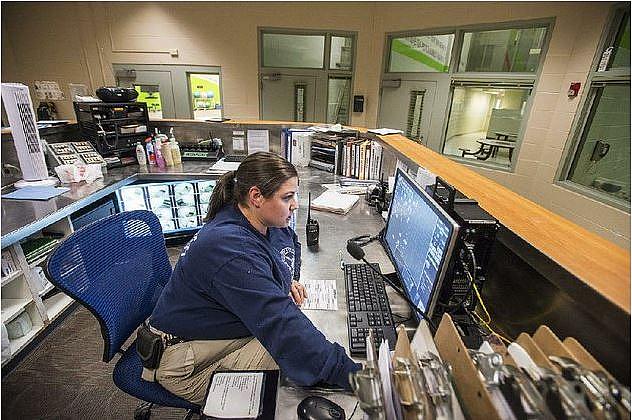How to overcome steep obstacles in juvenile justice reporting

A view from the inside of a youth lockup facility.
It’s incredibly easy for the government to take away a child’s liberty, but it can be incredibly difficult to explain that process so that people will care.
That’s what I found while reporting and writing my fellowship project, supported by the Fund for Journalism on Child Well-Being and the National Health Journalism Fellowship.
The articles that I wrote for the Arkansas Democrat-Gazette focused on inequality in the Arkansas juvenile court system when it comes to the treatment of status offenders — children who haven’t committed adult crimes but have broken laws that only apply to those under 18.
These kids are truants, runaways and the “incorrigible.” Under state and federal laws, these children are supposed to be treated differently than youth who commit serious crimes.
But the stories explored how each year hundreds of these children end up in youth lockups for months along with children who have committed for more serious crimes — rapes, robberies and murders. We also found that these youth are treated differently based upon where they live. (You can read the stories here, and here.)
In reporting these stories, my editor and I came up against several obstacles that many reporters will find in juvenile justice systems across the U.S.
Juvenile court hearings in Arkansas are generally closed to the public. Court records are off limits. Youth lockups rarely allow interviews. Some even bar reporters from seeing the youth. And the information that the state does allow the public to know about these youth is limited and many times flawed.
We didn’t overcome all of these problems, but here are some of the insights we gleaned while reporting the stories.
It never hurts to ask. For the stories, I interviewed more than 40 people in the juvenile justice system. The majority of these people rarely talk publicly about their jobs. This is largely because they’re supposed to keep certain things secret to protect the future of the children they serve. But I’ve found that many people in the system understand that secrecy can hurt children and allow serious problems to go unaddressed. Over the months of reporting, the more I explained what I was doing, the more people were willing to talk and help. This was the key when it came to observing family court in northwest Arkansas. I asked and expected a “No.” Instead, the judge agreed. Our stories heavily relied on recounting the story of one girl’s experience during that day in family court. Getting to her story took months of asking judges and officials if I could observe hearings and review documents that are usually off-limits to the public. It paid off by giving readers a concrete — and heart-breaking — example.
Be there and stay as long as you can. The average person has an idea of what a youth jail looks like, but few have actually seen the inside. Steel bunks. Thin mattresses. Tiny windows. Doors that lock all the time. That’s where these children live. It’s important for reporters to document how the state treats youth. Details matter and the best way to get them is to be there and hang around as long as you can, or as the guards will allow.
Interview your data — and assume it’s lying. “Garbage-in, garbage-out” is the rule, not the exception, when it comes to juvenile justice data. The federal government is reliant on the states for much of its data, and the states are often reliant on a 20-year-old guard with a high-school education filling out a complex spreadsheet. Errors abound. This was especially true for the data on status offenders. We found that for 2013 the state had reported data to the federal government that grossly undercounted the number of kids detained because a large portion of lockups just didn’t turn in their reports. The data for 2014 was complete, but suspect. I ended up spending the better part of two months vetting the numbers with judges, lockups and court staff. We found this data had some serious flaws. As with any data story, we used some general rules of thumb during the reporting.
- Get the documents or forms that are the basis for the data. This will help you to understand the strengths and weaknesses of the data.
- Talk to the person who handles the data every day. This can save you a lot of time by getting your questions answered by the person who knows it best.
- Make a copy of the dataset and leave the original alone. Always work off this copy and keep an audit journal of what you do during your analysis so you can fact check it later.
- Once you analyze your data, vet it with other sources to confirm your findings or locate errors in the data. Look for other data or sources that can help explain your findings to your readers.
- Before you publish, do the entire analysis again, following the steps outlined in your audit journal. This will help you spot any errors. Oh, and do it a third time just to be extra sure.
Cut through the jargon and tell a story. Status offender. Juvenile detention center. Valid court order exception. To a juvenile justice expert, these are common terms. For a reader, these terms mean, “I should stop reading.” We did our best to avoid these terms when we could and to use words that actually mean something to readers instead — like child, jail and law. The more concrete the words, the better the story you tell.
[Photo courtesy Arkansas Democrat-Gazette]

